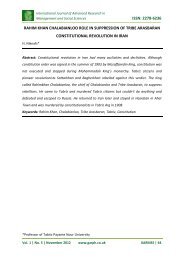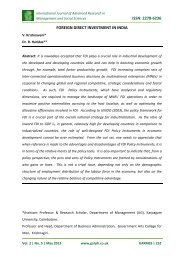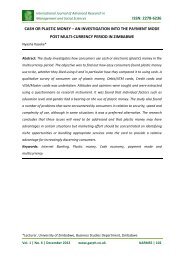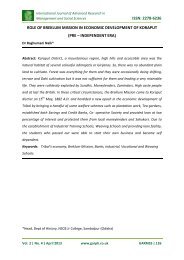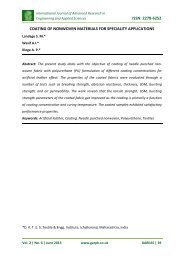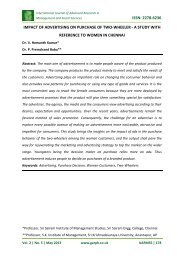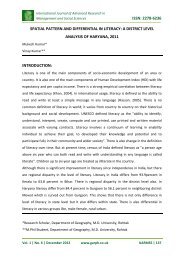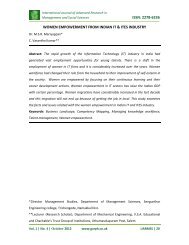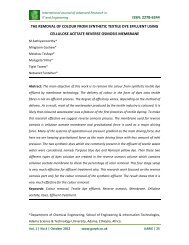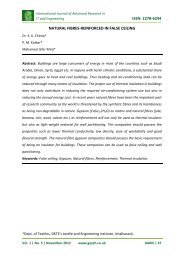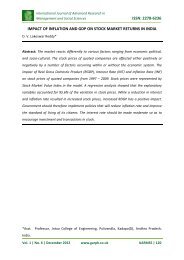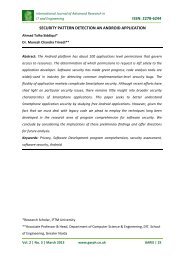CONSTRUCTION OF SINGLE SAMPLING PLAN ... - Garph.co.uk
CONSTRUCTION OF SINGLE SAMPLING PLAN ... - Garph.co.uk
CONSTRUCTION OF SINGLE SAMPLING PLAN ... - Garph.co.uk
Create successful ePaper yourself
Turn your PDF publications into a flip-book with our unique Google optimized e-Paper software.
International Journal of Advanced Research in<br />
IT and Engineering ISSN: 2278-6244<br />
1. INTRODUCTION<br />
Mixed sampling plans <strong>co</strong>nsist of two stages of rather different nature. During the first stage<br />
the given lot is <strong>co</strong>nsidered as a sample from the respective production process and a<br />
criterion by variables is used to check process quality. If process quality is judged to be<br />
sufficiently good, the lot is accepted. Otherwise the se<strong>co</strong>nd stage of the sampling plan is<br />
entered and lot quality is checked directly by means of an attribute sampling plan.<br />
There are two types of mixed sampling plans called independent and dependent plans. If<br />
the first stage sample results are not utilized in the se<strong>co</strong>nd stage, the plan is said to be<br />
independent otherwise dependent. The principal advantage of a mixed sampling plan over<br />
pure attribute sampling plans is a reduction in sample size for a similar amount of<br />
protection.<br />
The se<strong>co</strong>nd stage attribute inspection be<strong>co</strong>mes more important to discriminate the lot if the<br />
first stage variable inspection fails to accept the lot. If rejection occurs during the normal<br />
inspection, tightened inspection is re<strong>co</strong>mmended in the mixed system and vice versa in the<br />
se<strong>co</strong>nd stage. Hence Quick Switching System is imposed in the se<strong>co</strong>nd stage to sharpen the<br />
sampling situation and to insist the producer to manufacture goods within the Limiting<br />
Quality Level. Dodge (1967) proposed a sampling system called a ‘Quick Switching System’<br />
(QSS) <strong>co</strong>nsisting of pairs of normal and tightened plans.<br />
Schilling (1967) proposed a method for determining the operating characteristics of mixed<br />
variables –attributes sampling plans, single sided specification and standard deviation<br />
known using the normal approximation. Devaarul (2003), Sampath Kumar (2007), Sampath<br />
Kumar, Indra and Radhakrishnan (2012a, 2012b, 2012c, 2012d) have made <strong>co</strong>ntributions to<br />
mixed sampling plans for independent case. Sampath Kumar et.al (2012) studied mixed<br />
sampling plan for independent case. QSSs were originally proposed by Dodge (1967) and<br />
investigated by Romboski (1969) and Govindaraju (1991).Dodge (1967) proposed a new<br />
sampling system <strong>co</strong>nsisting of pairs of normal and tightened<br />
with attributes by Romboski (1969)<br />
plans. QSS developed<br />
is a reduction in the sample size required to<br />
achieve approximately the same operating characteristic curve.<br />
In this paper, using the operating procedure of mixed sampling plan with QSS-2(n;c N ,c T ) plan<br />
as attribute plan, tables are <strong>co</strong>nstructed for the mixed sampling plan indexed through (i)<br />
Vol. 1 | No. 2 | August 2012 www.garph.<strong>co</strong>.<strong>uk</strong> IJARIE | 20





